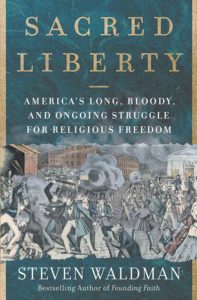Sacred Liberty: America’s Long, Bloody, and Ongoing Struggle for Religious Freedom
Reviewed by Cameron McWhirter
November 1, 2019
 By Steven Waldman. HarperOne, 2019. 416 pages. $28.99/hardcover; $12.99/eBook.
By Steven Waldman. HarperOne, 2019. 416 pages. $28.99/hardcover; $12.99/eBook.
People of all political stripes living in the United States pay lip service to the principle of religious liberty as sacred and indissoluble. Then they fight constantly about what exactly they mean by the claim.
Steven Waldman’s Sacred Liberty shows such battles have been perpetual throughout the nation’s history. Waldman, a journalist and co-founder of Beliefnet, a “lifestyle site dedicated to faith and inspiration,” has produced a solid if somewhat cursory historical survey of our nation’s fraught relationship with religious freedom, and shows how tenuous the concept’s acceptance has been from the early days of the colonies. Far too often, people have embraced religious freedom as long as it’s for their own belief and not faiths they consider strange.
Puritans fled to New England because of religious persecution; then they turned around and executed Quakers, including Mary Dyer, for heresy. Anglicans in Virginia beat and harassed Baptists. Protestants attacked Catholics and “Popery,” destroying convents and beating up priests. Some state governments passed laws barring Catholics and Jews from holding office. Everyone attacked the Mormons, with a Missouri governor once signing an executive order calling for their extermination. Native Americans had their religions suppressed by Christian-run government schools. Enslaved Africans had their traditional faiths erased or pushed into the shadows. Self-styled patriots attacked Jehovah’s Witnesses for refusing to salute the flag during World War II. Deep distrust of Muslims abounds in the United States today.
The history of religious freedom in our nation is messy and bloody. Americans have fought over Bibles, mosques, schools, and who can hold office. Even which stones were to be used for the Washington Monument became a religious fight.
But the Constitution’s embrace of the principle of religious freedom, enshrined in the First Amendment, has been a way for religious minorities to defend their faiths against majority efforts to stifle or destroy them, Waldman argues. One of the key heroes of his book is James Madison, who coordinated passage of the Virginia Statute for Religious Freedom and pushed for similar ideas for the Constitution and the Bill of Rights. Madison’s goal was simple and revolutionary: create laws requiring the government to protect all religions in American society. Madison, “this underappreciated founder” as Waldman calls him, “believed that the surest path to religious liberty would come from a ‘multiplicity of sects,’ a diversity of different denominations all jostling for followers.” Madison wanted an open marketplace for religious ideas—a marketplace that today includes the idea of not being religious at all.
This book is excellent at exploring and summarizing past events. It can be less satisfying as it approaches contemporary times, trying to critique the Trump era and what it means for our nation’s religiosity (or lack thereof) in the future as we become a nation with no single dominant faith.
Waldman argues persuasively that religious freedom coupled with the fervor of new religious movements have sparked great transformations in American society, from abolition to women’s rights to the Civil Rights Movement to gay marriage. The aspirational goal of true and complete religious tolerance, first promoted by Madison, has made us a better country by checking the base impulse of majorities to push out or oppress minorities. But as Sacred Liberty illustrates, society must be ever vigilant because that impulse is never completely erased.



Comments on Friendsjournal.org may be used in the Forum of the print magazine and may be edited for length and clarity.